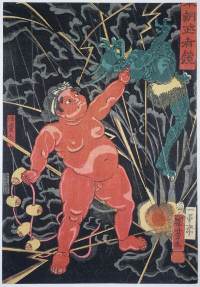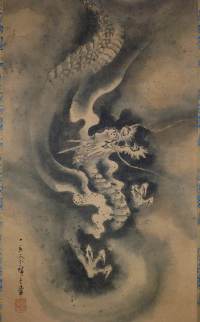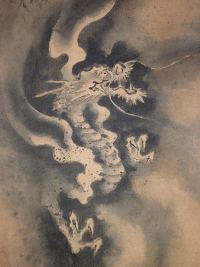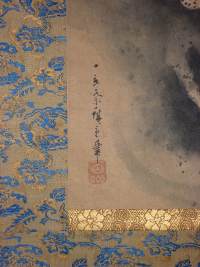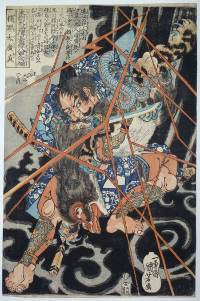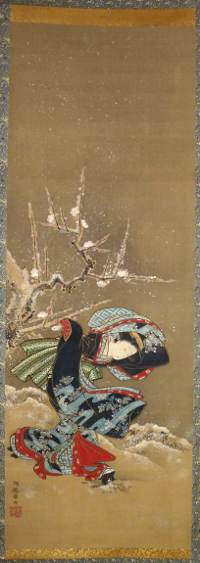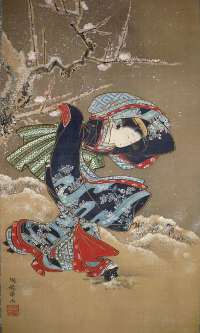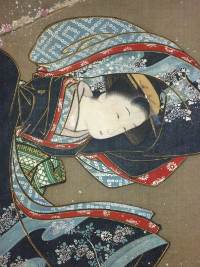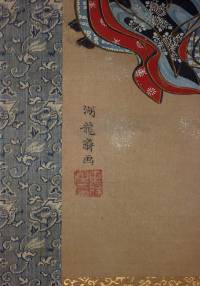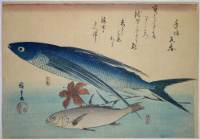Utagawa KUNIYOSHI (1797-1861)
Click here to view image full size.
Kwaido Maru (Kintoki) seizes Raijin, the Thunder God, with one hand while holding his thunder drums with the other. A thunderbolt falls to earth causing flashes of lightning. A fine and rare set: Honcho musha kagami, “Mirror of Warriors of our Country.” The set published by Tsujioka-ya Bunsuke, 1855. Robinson S87.6.
Fine impression. Slightly trimmed, otherwise very good condition. Signed Ichiyusai Kuniyoshi ga.
Status: Sold
Ichiryusai HIROSHIGE (1797-1858)
Click here to view image full size.
A newly discovered painting of a three-clawed Kano-style dragon amongst clouds. Although a subject popular with Japanese artists (and especially Chinese artists where the subject derives from), this appears to be the only such painting by Hiroshige extant. He did, however, produce two prints of the subject – a surimono and a large panel, both of around the same date. The signature indicates a date after 1840 and it was most likely painted for the Dragon Year 1844. Blue and brown ink on paper with extensive splashed ink. Image size 34.5 x 10.5 in; 87.7 x 26.7 cm. The mount uses a ryu-mon (dragon pattern) motif to match the subject. Very good condition. Signed Ichiryusai Hiroshige hitsu with Ichiryusai seal.
Status: Sold
Utagawa KUNIYOSHI (1797-1861)
Click here to view image full size.
Hironao no Hayata (Tadazumi no Hayata), Yorimasa’s retainer (see the triptych by Kuniyoshi of the same subject on this update), grappling with the composite beast Nue on the roof of the Shishinden Palace. Forked lightning bounces around him. One of the best designs from Honcho Suikoden goyu happyaku-nin no hitori, “Eight Hundred Heroes of our Country’s Suikoden, One by One.” Published by Kagaya Kichiemon, 1830-31.
Very good impression and colour. Slight trimming, otherwise very good condition. Signed Ichiyusai Kuniyoshi ga.
Status: Sold
Isoda KORYUSAI (FL c 1764-1788)
Click here to view image full size.
A superb original painting, full colour on silk, showing a beauty running in a late snowfall. Cherry blossom above. A leading artist of his time who produced some of the best bijin and kacho prints of the 1770s before concentrating on painting. Image size 40.25 x 14.25 in; 102.5 x 36 cm. Good condition. Painted c 1778. Signed Koryusai ga with seal Masakatsu, no in.
Status: Sold
Utagawa HIROSHIGE (1797-1858)
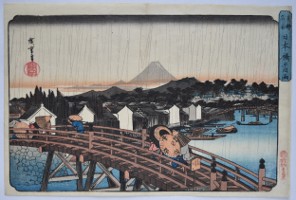
Click here to view image full size.
Nihonbashi no hakuu, “Light Rain on Nihon Bridge.” From a Toto meisho set of 21 designs published between c. 1832 and 1839 by Kikakudo. The set was subsequently enlarged. Shows figures crossing Nihonbashi in rain, one figure carries an umbrella with the publisher’s name. Warehouses in the background and a distant view of Fuji. A beautiful print and very difficult to find in early impression: The title cartouche had a plug inserted beside the bottom three characters of the title on the left. This damage seems to have occurred when the block was cut and over time the spigot gradually slipped out leaving an unprinted area (which is sometimes painted in). In the earliest impressions the plug is hardly visible (as here). Also, the publisher’s seal at the bottom right should be in red, later editions having it in black. There was also an early variant edition with a yellow sky.
Fine impression and colour. Imperceptible centre fold, also near the right edge, otherwise very good condition. Signed Hiroshige ga.
Status: Sold
Ichiryusai HIROSHIGE (1797-1858)
Click here to view image full size.
Tobiuo, flying fish (probably Prognichthys) and ishimochi also called guchi or shiroguchi, white croaker, (probably Argyrosomus argenatus). Together with a single lily. Poem by Toshigaki Maharu. From the second series of ten fish prints published by Yamasho, c1840-42.The first series was issued privately for a poetry group ( probably the Shingyoku Circle ) with judges’ names and extra poems. These prints are of the utmost rarity as probably only enough for the Circle were printed and they never come onto the market. Due to their popularity this first series was published commercially and a second set was commissioned.
Fine, early impression with mica on the flying fish. Fine colour and condition. Full size and no centre fold. Signed Hiroshige ga in blue (which I have never seen).
Status: Sold
Utagawa TOYOKUNI II (TOYOSHIGE) (1777-1835)
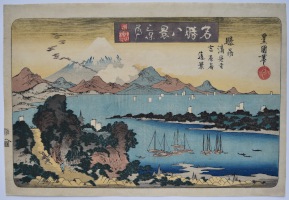
Click here to view image full size.
Returning Geese at Miho: Kiyomizu Temple of Suruga Province with a Distant View of Yoshiwara from Meisho hakkei, “Eight Views of Famous Places.” A popular theme in Japanese art originating in China and the landscape of the Xiaoxiang region where the Xiao and Xiang rivers converge. Published c 1833-4 by Kinjudo.
Fine impression, colour and condition. The pigment in the title cartouche intact, which is usually faded. Signed Toyokuni hitsu.
Status: Sold
Ikeda EISEN (1790-1848)
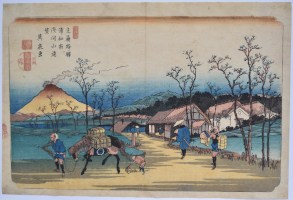
Click here to view image full size.
Urawa Shuku Asamayama enbo, “Urawa Station, Distant View of Mount Asama” from Kisokaido rokujukyutsugi no uchi, “Sixty-Nine Stations of the Kisokaido.” The set was published by Hoeido and Kinjudo, 1834-1842. The first 23 (of 70) prints were designed by Eisen, the rest by Hiroshige. In the distance can be seen a smoking Mount Asama. Although there is regular volcanic activity, the last bad eruption was in 1783.
Very good impression of the first edition with signature. (This was removed on later states.) Very good colour. Slight centre fold, otherwise very good condition. Signed Eisen ga.
Status: Sold
Ichiryusai HIROSHIGE (1797-1858)
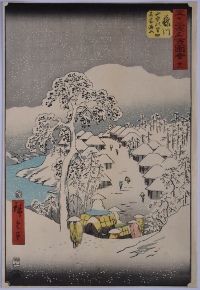
Click here to view image full size.
Fujikawa from the so-called “Upright Tokaido.” One of the two snow scenes from the set. Shows travelers coming and going at the edge of the village. Published by Tsutaya, Hare 7, 1855.
Very good impression with wood-grain evident in the sky. Very good colour. Trimmed close, otherwise very good condition. Signed Hiroshige ga.
Status: Sold
Utagawa HIROSHIGE (1797-1858)
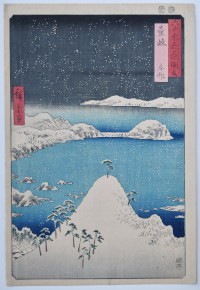
Click here to view image full size.
Iki Shisaku, “Shisaku in Iki [Province]” from a set of 69 prints [Dai Nihon] Rokujuyoshi meisho zue, “Famous Places in the Sixty-odd Provinces [of Japan]” published by Koshihei between 1853 and 1856, this being 1856. A heavy snowfall over Iki island which lies to the northeast of the Kyushu coast in southern Japan.
Very fine impression and colour. Light album backing, otherwise fine condition. Signed Hiroshige ga.
Status: Sold
Utagawa HIROSHIGE (1797-1858)
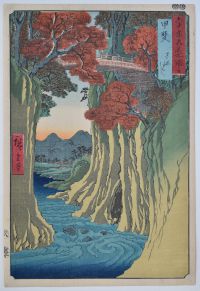
Click here to view image full size.
Kai, Saruhashi, “Kai [Province], Monkey Bridge” from a set of 69 prints [Dai Nihon] Rokujuyoshi meisho zue, “Famous Places in the Sixty-odd Provinces [of Japan]” published by Koshihei between 1853 and 1856, this being 1853. The bridge spans the Katsura River and is an example of the hanebashi method of construction whereby cantilever beams are set in the opposing cliff faces. Called the Monkey Bridge because monkeys are originally supposed to have strung themselves across the gorge.
Very fine impression and colour. Light album backing, otherwise fine condition. Signed Hiroshige ga.
Status: Sold
Utagawa HIROSHIGE (1797-1858)
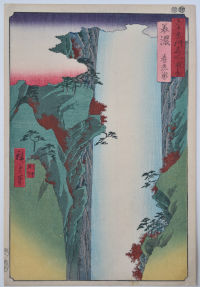
Click here to view image full size.
Mino, Yoro no taki, “Mino [Province], Yoro Waterfall” from a set of 69 prints [Dai Nihon] Rokujuyoshi meisho zue, “Famous Places in the Sixty-odd Provinces [of Japan]” published by Koshihei between 1853 and 1856, this being 1853. The 32 metre fall is 4 metres wide and is located in Yoro Park, near Nagoya.
Very fine impression and colour with blind-printing on the fall. Light album backing, otherwise fine condition. Signed Hiroshige ga.
Status: Sold
Utagawa HIROSHIGE (1797-1858)
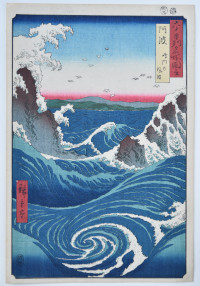
Click here to view image full size.
Awa, Naruto no fuha, Naruto Whirlpools, Awa [Province]” from a set of 69 prints [Dai Nihon] Rokujuyoshi meisho zue, “Famous Places in the Sixty-odd Provinces [of Japan]” published by Koshihei between 1853 and 1856, this being 1855. The finest print from the set and one of Hiroshige’s most important designs. The phenomenon is caused by the tides that move large amounts of water through the Naruto Strait into and out of the Inland Sea.
Very fine impression and colour. Light album backing, otherwise fine condition. Signed Hiroshige ga.
Status: Sold
Utagawa HIROSHIGE (1797-1858)
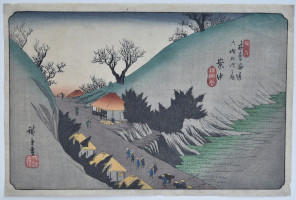
Click here to view image full size.
Station Annaka from Kisokaido rokujukyutsugi no uchi, “Sixty-Nine Stations of the Kisokaido.” Published by Kinjudo, the set was started by Eisen in 1835 who designed twenty-four prints before Hiroshige replaced him and completed the set before 1843. Shows the entourage of a feudal lord progressing along the road between rest houses.
Very fine impression of the earliest printing. Fine colour and condition. Signed Hiroshige ga.
Status: Sold
Utagawa HIROSHIGE (1797-1858)
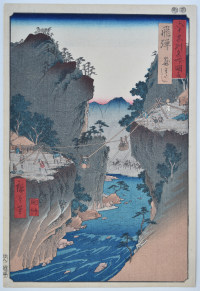
Click here to view image full size.
Hida, kago-watashi, “Basket Ropeway in Hida [Province]” from a set of 69 prints [Dai Nihon] Rokujuyoshi meisho zue, “Famous Places in the Sixty-odd Provinces [of Japan]” published by Koshihei between 1853 and 1856, this being 1853. Originating in China, Japan and northern India, travellers could cross deep ravines by suspending themselves in a harness which evolved into a basket.
Very fine impression and colour. Light album backing, otherwise fine condition. Signed Hiroshige ga.
Status: Sold
Katsushika HOKUSAI (1760-1849)
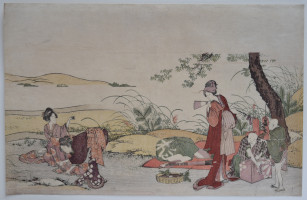
Click here to view image full size.
A group of three women picking mushrooms. Published c 1800. Another impression, from the Musee Guimet, is illustrated in Muneshige Narazaki, Ukiyo-e Masterpieces in European Collections, 6, Musee Guimet, Paris, 1, p. 176, no. 90.
Fine impression. Very good colour and condition. Unsigned.
Status: Sold
Utagawa HIROSHIGE (1797-1858)
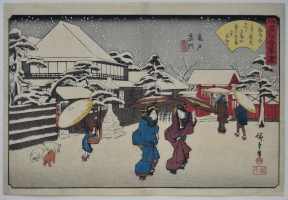
Click here to view image full size.
A snow scene from a set Edo komei kaitei zukushi, “Famous Teahouses of Edo,” Kameido uramon, Tamaya, “Back Gate of the Shrine at Kameido: The Tamaya Teahouse.” The set published by Shogendo, 1838-40.
Very fine impression. Fine colour. Slight centre fold (strengthened au verso), otherwise very good condition. Signed Hiroshige ga.
Status: Sold
Utagawa HIROSHIGE II (1826-1869)
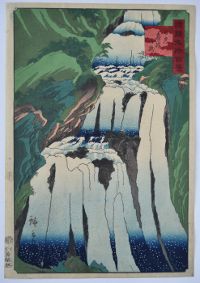
Click here to view image full size.
Nikko Shimofuri no taki, “Shimofuri Waterfall in Nikko” from Shokoku meisho hyakkei, the “Hundred Views of Famous Places in the Provinces.” An uncompleted set of 81 prints published by Uoya Eikichi between 1859-1861 (this being 1859).
Very fine impression of the first edition. Fine colour and condition. Signed Hiroshige ga.
Status: Sold
Utagawa HIROSHIGE II (1826-1869)
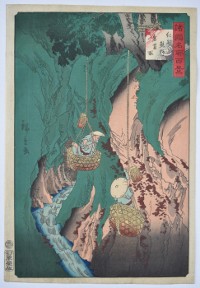
Click here to view image full size.
Gathering iwatake, rock tripe or rock mushrooms in Kii Province. The common name for various edible lichens that grow on cliffs. The gatherers used precarious baskets that were hauled up and down the cliff face to collect them. Kishu Kumano iwatake tori from Shokoku meisho hyakkei. “Hundred Views of Famous Places in the Provinces.” Published by Uoyei 1859-1861 (this being 1860).
Very fine impression of the first edition. Fine colour and condition. Signed Hiroshige ga.
Status: Sold
Utagawa HIROSHIGE (1797-1858)
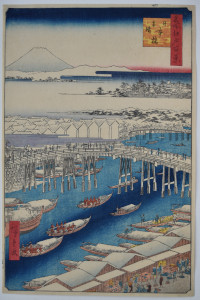
Click here to view image full size.
Nihonbashi yukibare, “The Nihon Bridge, Clear Weather After Snow.” From the set Meisho Edo hyakkei, “One Hundred Views of Edo.” The set published by Uoya Eikichi 1856-58 (this being 1856). The set comprises 118 prints by Hiroshige and another by Hiroshige II. However, three prints are dated 10/1858, the month following Hiroshige’s death and these are thought to be by Hiroshige II as well. They are: Ueno Yamashita, Ichigaya Hachiman and Bikunibashi. Number 1 from the set and a view of the Sumida River with Mt. Fuji in the distance. This is the starting point for the Tokaido Road.
Fine, early impression with gradation on the roofs and on Mt. Fuji. Fine colour. Margins trimmed a little, otherwise very good condition. Signed Hiroshige ga.
Status: Sold
Utagawa HIROSHIGE (1797-1858)
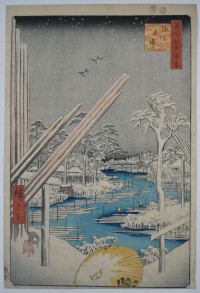
Click here to view image full size.
The lumberyard, Fukugawa, from the set Meisho Edo hyakkei, “One Hundred Views of Edo.” The set published by Uoya Eikichi 1856-58 (this being 1856). The set comprises 118 prints by Hiroshige and another by Hiroshige II. However, three prints are dated 10/1858, the month following Hiroshige’s death and these are thought to be by Hiroshige II as well. They are: Ueno Yamashita, Ichigaya Hachiman and Bikunibashi. Shows snow falling on the timber yards lining a river. An umbrella in the foreground is inscribed Uo, “Fish” – a reference to the publisher Uoya Eikichi. A large supply of timber was needed for the world’s largest wooden city. However, in 1641 a fire destroyed not only houses but the lumber which was then stored in a central area forcing the government to move the yards to Fukugawa.
Very good, early impression. Very good colour. Trimmed close at bottom. Otherwise very good condition. Signed Hiroshige ga.
Status: Sold
Utagawa HIROSHIGE (1797-1858)
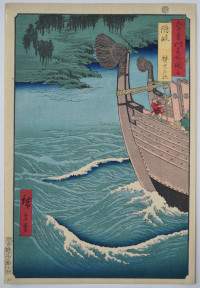
Click here to view image full size.
Oki Province, Takuhi Shrine. From a set of 69 prints [Dai Nihon] Rokujuyoshu meisho zue, “Famous Places in the Sixty-odd Provinces [of Japan]” published by Koshihei between 1853 and 1856, this being 1853. The prows of two boats near the island of Nishinoshima. A torii seen at the top of the print indicates the Takuhi Shrine, one of the most important shrines dedicated to the gods of the sea.
Fine impression and colour. Light album backing, otherwise very good condition. Signed Hiroshige ga.
Status: Sold
Utagawa HIROSHIGE II (1829-1869)
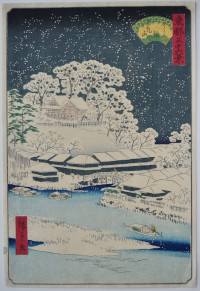
Click here to view image full size.
A snow scene: Imadobashi Matsuchiyama, “Imado Bridge and Matsuchi Hill.” From Toto sanjurokkei, “Thirty-six Views of the Eastern [Edo] Capital.” The set published by Ai-To between 1861-1862 (this being 1862). Hiroshige I also designed a number of prints of the same area. The bridge goes over the Sanya Canal.
Fine impression, colour and condition. Signed Hiroshige ga.
Status: Sold
Utagawa HIROSHIGE II (1829-1869)
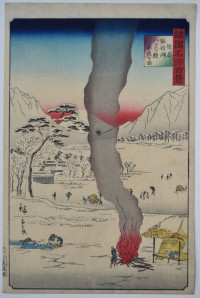
Click here to view image full size.
Shinshu Suwa-ko yatsume akauo wo to (ru). Shinshu (Shinano) Province from Shokoku meisho hyakkei, “Hundred Views of Famous Places in the Provinces.” An uncompleted set of 81 prints published by Uoya Eikichi between 1859-1861 (this being 1860). A winter scene showing figures catching lampreys, eels and red rockfish in Lake Suwa. The lake was unusual in having warm currents beneath the ice, even in mid winter.
Fine impression of first edition. Fine colour and condition. Signed Hiroshige ga.
Status: Sold
Utagawa KUNIYOSHI (1797-1861)
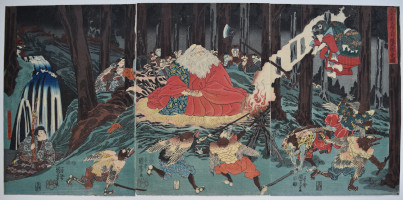
Click here to view image full size.
A triptych showing Ushiwaka Maru (Minamoto no Yoshitsune’s childhood name), attended by Kisanda, practising fencing with the karasu or “crow” tengu in a forest glade on Mt. Kurama, north of Kyoto. His training in martial arts is being supervised by a white-bearded yamabushi tengu, Sojobo, King of the Tengu. (The yamabushi were followers of Shugendo– a shamanistic mountain ascetism.) Yoshitsune (1159-1189) is the best known Japanese warrior and a popular subject for Japanese artists and craftsmen. Famous for exploits such as the battle on Gojo Bridge with Benkei and the battle of Dan-no-ura. Published by Enshuya Hikobei, 1851-2. Robinson T264.
Fine impression. This is the first state with gradation on the rocks top left. Fine colour. Very good condition. Signed Ichiyusai Kuniyoshi ga.
Status: Sold
Ichiryusai HIROSHIGE (1797-1858)
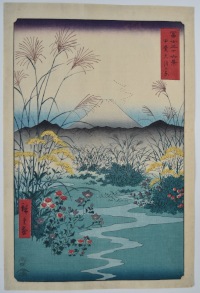
Click here to view image full size.
Kai Otsuki no hara, “Otsuki [“Great Moon”] Plain in Kai Province.” The most popular print from Fuji sanjurokkei, “The Thirty-six Views of Fuji.”Published by Tsutaya Kichizo, 4/1858. A distant view of Fuji with a stream meandering amongst wild flowers. Some of them are from the Seven Herbs (Nanakusa) of Autumn, being: pampas grass, susuki, yellow patrinia, ominaeshi, bellflowers, kikyo, and wild carnations, tokonatsu.
Fine impression, colour and condition. Signed Hiroshige ga.
Status: Sold
Ichiryusai HIROSHIGE (1797-1858)
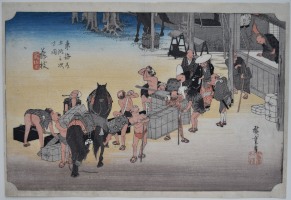
Click here to view image full size.
Fujieda from Tokaido gojusan tsugi, “The Fifty-three Stations of the Tokaido.” The set of fifty-five prints was published jointly by Hoeido and Senkakdo in 1834. Shows porters unpacking at the relay station. It was here that fresh horses could be obtained, luggage weighed, labour arranged, and payments made. Hiroshige’s most famous set that was reprinted many times.
Fine early impression: The porter just off-centre rubbing his back with a towel has a small area on his head that does not print on the earliest impressions, which was later corrected. Fine colour. Very slight centre fold, otherwise fine condition. Signed Hiroshige ga.
Status: Sold
Ichiryusai HIROSHIGE (1797-1858)
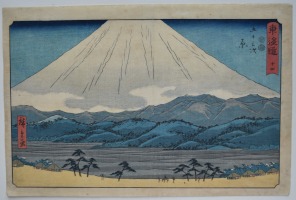
Click here to view image full size.
Hara from The Fifty-three Stations of the Tokaido published by Marusei, Maruya Seijiro, 1847-52. Called the Reisho Tokaido because of the angular style of Kanji used. Shows Fuji towering over the landscape with miniscule figures on the road at the bottom. One of the best designs from the set.
Fine impression and colour. Very slight centre fold, otherwise very good condition. Signed Hiroshige ga.
Status: Sold
Ichiryusai HIROSHIGE (1797-1858)
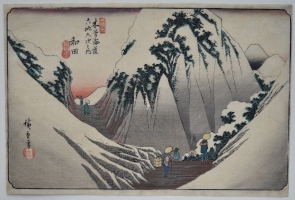
Click here to view image full size.
Wada from the Sixty-nine Stations f the Kisokaido. The set was started by Eisen and published by Hoeido in 1835, but in 1837 Hiroshige took over and completed the series with the publisher Iseiri (Kinjudo). Wada is the highest point on the Kisokaido and Hiroshige shows travellers traversing the snow covered pass.
Very good impression and colour. Minimal edge soil and trimming, otherwise very good condition. Signed Hiroshige ga.
Status: Sold
Ichiryusai HIROSHIGE (1797-1858)
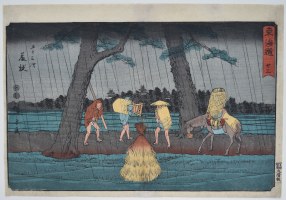
Click here to view image full size.
Fujieda from The Fifty-three Stations of the Tokaido published by Marusei, Maruya Seijiro, 1847-52. Called the Reisho Tokaido because of the angular style of Kanji used. Travellers huddled against the rain on a narrow path. One of the best designs from the set.
Fine impression and colour. Very good condition. Signed Hiroshige ga.
Status: Sold
Utagawa HIROSHIGE (1797-1858) and Utagawa KUNISADA (1786-1864)
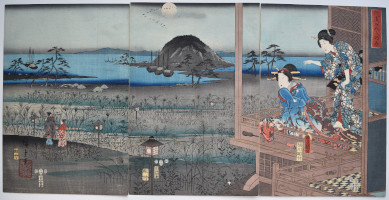
Click here to view image full size.
A triptych from a set: Furyu Genji: Akashi. An evening scene showing Genji’s secret lover Lady Fujitsubo and an attendant watching the departing Prince Genji walking through the reeds of Akashi Bay. Based on the famous Genji monogatari written by the 11th century noblewoman and lady-in-waiting Murasaki Shikibu. Published by Iseya Kanekichi 1853.
Fine impression. This is the early state with gradation over the moon. Fine colour. Very slight trimming and retains album backing, otherwise very good condition. Signed Hiroshige ga and Toyokuni ga.
Status: Sold
Utagawa KUNIYOSHI (1797-1861)
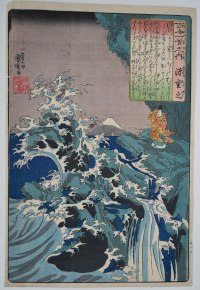
Click here to view image full size.
A poem by the celebrated poet Minamoto no Shigeyuki from the series Hyakunin isshu no uchi, “One Hundred Poems for One Hundred Poets” which was compiled in 1235 by Fujiwara Teika (1162-1241). Shows the poet on a craggy outcrop with waves crashing around him; Fuji in the distance. One of the best designs in the set published by Ebisuya Shoshichi, Ebine, 1840-42. Only 58 of the 100 are known. Various translations of the poem exist, here is one:
Waves that beat against the rocks
Fanned by a fierce wind –
It is I alone
Who breaks, those times
When I think of her
Very fine impression. Fine colour and condition. Signed Ichiyusai Kuniyoshi ga. Hiroshige ga.
Status: Sold
Utagawa HIROSHIGE (1797-1858)
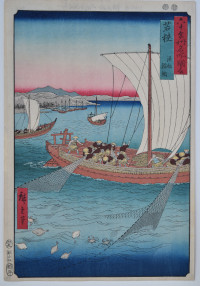
Click here to view image full size.
Wakasa, Gyosen karei-ami, “Fishing Boats and Flounder Nets in Wakasa [Province]” from a set of 69 prints [Dai Nihon] Rokujuyoshi meisho zue, “Famous Places in the Sixty-odd Provinces [of Japan]” published by Koshihei between 1853 and 1856, this being 1853. Fishing in Wakasa Bay. The highway between the Wakasa ports and Kyoto was nicknamed the “Mackerel Highway” because of the quantity of fish that was transported.
Very fine impression and colour. Light album backing, otherwise fine condition. Signed Hiroshige ga.
Status: Sold
Utagawa HIROSHIGE (1797-1858)
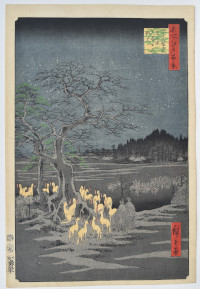
Click here to view image full size.
Oji Shozoku enoki, Omisoka no kitsunebi, “Foxfires on New Year’s Eve at the Shozoku Hackberry Tree, Oji,” from Meisho Edo hyakkei, “The One Hundred Famous Views of Edo,” published by Uoya Eikichi 1856-58 (this being 1857). This is the only design from the set where Hiroshige uses historical fantasy: Every New Year’s Eve foxes gathered at the ancient enoki tree to pay their respects to their fox patron in the nearby Inari shrine at Oji, in northern Edo. The shrine was dedicated to the god of the harvests and farmers would predict the outcome of a harvest by the amount of kitsunebi (fox flames) they saw emitted by the foxes. A popular print from the set.
Very good impression, colour and condition. Signed Hiroshige ga.
Status: Sold
Utagawa HIROSHIGE (1797-1858)
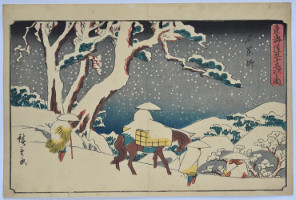
Click here to view image full size.
Ishiyakushi from an aiban set Tokaido gojusantsugi no uchi, commonly called the Gyosho Tokaido because of the cursive script on title. Shows travellers entering and leaving the village in heavy snow. Published by Ezakiya Kichibei/Yamadaya, c. 1841-2. There are variant states: later editions lack the gradation on the horizon. The first state may have a Hiroshige seal after the signature.
Very good impression and colour. Slight centre fold, otherwise very good condition. Signed Hiroshige ga.
Status: Sold
Kikukawa EIZAN (1787-1867)
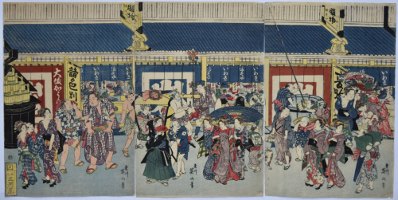
Click here to view image full size.
A triptych showing a street thronged with people in front of the famous department store Iwaki Masuya, giving a good cross-section of the inhabitants of the city at this time. The store specialised in silk and textiles and was one of the most important in Edo having, at one point, 500 employees in its stores. Hiroshige designed another triptych of this subject in c. 1850.
Published by Mikawaya Seiemon, c. 1815. Rare.
Fine impression. Extremely fine fresh colour. Fine condition. Full size. Signed Kikukawa Eizan fude.
Status: Sold
Utagawa HIROSHIGE (1797-1858)
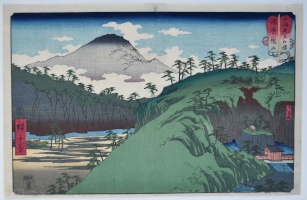
Click here to view image full size.
Harima Tatsuyama, “Mount Tatsu [Dragon] in Harima [Province]” from a set of twenty prints Sankai mitate zumo, “Wrestling Matches Between Mountains and Sea.” A fanciful and imaginative title lacking in other Hiroshige sets. Comprises of ten prints of mountains and ten prints of harbours. Published by Yamadaya Shojiro, 1858. The title is in a wrestling umpire’s fan (gunbai).
Very fine impression of the first edition. Later printings have a solid red in the title cartouche instead of variegated colour and lack other subtleties. Fine colour. Very slight centre fold and minimal soil bottom left margin, otherwise very good condition. Signed Hiroshige ga. Hiroshige ga.
Status: Sold
Utagawa HIROSHIGE (1797-1858)
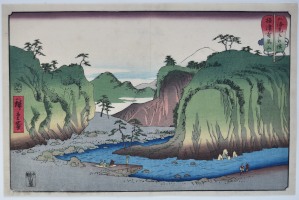
Click here to view image full size.
Settsu Arimayama, “Mount Arima in Settsu [Province]” from a set of twenty prints Sankai mitate zumo, “Wrestling Matches Between Mountains and Sea.” A fanciful and imaginative title lacking in other Hiroshige sets. Comprises of ten prints of mountains and ten prints of harbours. Published by Yamadaya Shojiro, 1858. The title is in a wrestling umpire’s fan (gunbai).
Very fine impression of the first edition. Later printings have a solid red in the title cartouche instead of variegated colour and lack other subtleties. Fine colour. Very slight centre fold and minimal soil bottom left margin, otherwise very good condition. Signed Hiroshige ga.
Status: Sold
Utagawa HIROSHIGE (1797-1858)
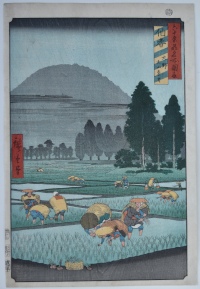
Click here to view image full size.
Hoki, ono Daisen enbo, “Hoki [Province], Distant View of Mount Daisen.” Shows rice-planting in the rain, with the volcanic mountain in the background. From a set of 69 prints [Dai Nihon] Rokujuyoshi meisho zue, “Famous Places in the Sixty-odd Provinces [of Japan]” published by Koshimuraya Heisuke between 1853 and 1856, this being 1853.
Very fine impression: This is the true first edition: Impressions with the bands of blue and yellow in the sub-cartouche are often catalogued as first editions but the impression must also have gradation on the top of the embankment at the bottom. Fine colour and condition. Signed Hiroshige ga.
Status: Sold
Utagawa HIROSHIGE (1797-1858)
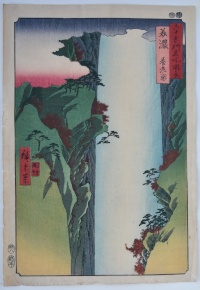
Click here to view image full size.
Mino, Yoro no taki, “Mino [Province], Yoro Waterfall” The 32 metre fall is 4 metres wide and is located in Yoro Park, near Nagoya. From a set of 69 prints [Dai Nihon] Rokujuyoshi meisho zue, “Famous Places in the Sixty-odd Provinces [of Japan]” published by Koshimuraya Heisuke between 1853 and 1856, this being 1853.
Fine, very early impression with extensive blind-printing on the fall. Fine colour. Some wrinkling of the large margins, otherwise very good condition. Signed Hiroshige ga.
Status: Sold
